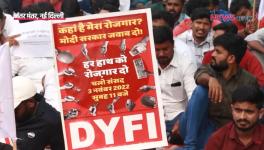A Year of Willful Economic Disaster
Image Courtesy: Shutterstock
THE uniqueness of 2017 lies in the fact that never before has the country seen a government-caused economic crisis as serious as was witnessed in this year. There have certainly been worse years for the people, such as 1965-66, 1966-67, and 1973-74, each of which saw massive inflation. But these were years when economic hardships occurred for reasons that had nothing to do proximately with government policy. 1965-66 and 1966-67 when the “Bihar famine” had occurred, had seen a sharp drop in food grains output, a drop that had lasted two years. The probability of such an event, statisticians told us at the time, was about one in two hundred.
One should not however just take the statisticians’ word for it. Many economists argue that growth impulses in Indian agriculture had dried up by the mid-sixties (before the Green Revolution provided a fresh impulse), and the reason for the sharpness of the drop at that time arose for this reason. In the early fifties there was still some scope for the expansion of net sown area, and such expansion provided the impulse for agricultural growth. By the time this had got exhausted, the irrigation projects initiated in the fifties were beginning to bear fruit, through an increase in multiple cropping on any given net sown area (which means through an increase in gross cropped area) and also through the increase in land productivity that irrigation permits. But this stimulus for agricultural growth too had got exhausted by the mid-sixties, so that agricultural output would have flattened out anyway. The drought of the mid-sixties acted on this flat curve, and that is why the drop was so sharp.
If this explanation, for which there is enough evidence, is accepted, then one can blame the government for not being prescient enough to forestall such a flattening of output. Even so however, one cannot hold the government proximately responsible for the economic hardships of the period. It can be accused at best of acts of omission, but not of any act of commission.
As for 1973-74 which saw the most rapid annual rate of inflation to date in India’s post-independence history, the reason for it lay in a combination of a poor harvest and the first of the “oil shocks”. The government should no doubt have prevented the second-order effects of the fall in food grains output by coming down on hoarders, and by releasing the stocks that it already had through the public distribution system rather than on the open market as it did (where the speculators whom such release was supposed to defeat actually bought up what was released). But these again were not the basic reason for the economic hardship experienced in that year. The basic reason was external to policy-decisions; policies could at best be blamed for not managing these external shocks better.
2017 however was altogether different. The world capitalist crisis no doubt was beginning to impinge on economies like India and China, but its impact was not the main reason for the hardships experienced in this year. Its impact on the balance of payments through an expansion of the current deficit, while potentially dangerous, was covered through a sufficient inflow of finance capital; indeed so large was the financial inflow that the year ended with the value of the rupee moving up against the dollar.
And as for the unemployment caused by the loss in export demand owing to the world crisis (and the “beggar-my-neighbour” policies in the form of protectionism it has generated in countries like the US), its impact on the people was much less than that of the willful measures introduced by the government itself. Likewise the distress caused to the peasantry by the drop in the prices of several cash crops, which is a part of the adverse movement in the terms of trade against primary commodities that has arisen with the spread of the world capitalist crisis to the “periphery” (of which a fall in China’s demand for such commodities is a symptom), was greatly accentuated by the government’s own willful measures.
In 2017 in other words it was not the government’s acts of omission, but its acts of commission, that lay primarily behind the economic hardships faced by the people. And such a situation where the government’s own acts of commission, undertaken gratuitously for no rhyme or reason, cause acute hardships to the people, has been unprecedented in the history of post-independence India.
The two prominent willful measures that squeezed the people were demonetisation, which, though introduced in November 2016, continued to cripple the petty production sector (the so-called “informal” economy) in 2017 as well, and the introduction of the Goods and Services Tax, ironically with much fanfare in the Central Hall of parliament, in a grotesque parody of the occasion where Jawaharlal Nehru had made his famous “Tryst with Destiny” speech.
There is a tendency to minimise the disruptive effects of these measures on the people’s lives by quoting GDP growth statistics, which, though they show a distinct fall, do not appear so alarming. But quite apart from the infirmities of the GDP estimates, on which even the government’s own Economic Survey has commented, and their susceptibility to the government’s propaganda needs (at least as far as the quick estimates are concerned), there is a fundamental methodological problem involved in the use of GDP estimates, even if they are assumed to be accurate. This arises because of the fact that sectors which account a small proportion of GDP provide employment to a far greater proportion of the work-force.
The agricultural sector for instance accounts for only around 15 per cent of the GDP but employs almost half the total work-force. Now consider a simple arithmetical example. Suppose the agricultural sector in any given year was to grow at 3 per cent and the non-agricultural sector (which I assume for simplicity to be one integrated whole) at 10 per cent. Then the overall growth rate of GDP in the economy for that year would be 8.95 per cent. But now suppose that owing to some measures of the government, the agricultural sector instead of growing by 3 per cent actually contracts by 5 per cent while the non-agricultural sector continues to grow at 10 per cent; then the overall growth rate of the economy drops to 7.75 per cent. The GDP growth rate falls by 1.2 per cent, from 8.95 to 7.75, which appears a small fall; but half the population of the country has witnessed an 8 per cent drop in its income compared to what it would otherwise have been in the absence of the government measure, from 103 to 95.
Thus the fact that a sector which accounts for a relatively small proportion of GDP provides employment and livelihood to a much larger proportion of the population, implies that measures affecting this large population scarcely make much difference to the GDP growth rate. Hence to conclude from this relatively small difference to GDP growth that the measures have not been harmful is a wrong inference. This alas is the kind of inference to which official spokesmen have been resorting.
In the example above, agriculture should be substituted by the “informal” sector generally, which accounts for about 45 per cent of GDP while providing employment to around 85 per cent of the work-force. It is this sector that has been decimated by demonetisation to start with, and by the GST subsequently. While the impact of demonetisation on this sector has been much discussed, that of the GST has been less so, and needs further discussion.
There are three obvious ways in which the GST has strangulated the “informal” sector: one, it has increased what economists call the “transaction costs” of such business in a number of ways, eg, by requiring the filling up of forms at frequent intervals. No doubt, transaction costs have increased for all businesses and not just for the “informal” sector, but large businesses already have an infrastructure in place for complying with such requirements, so that at the margin they have to spend less; but not so the “informal” sector.
The second way in which the informal sector is strangulated is through an increase in the average tax-rate now required to be paid by it. The purported objective of the GST regime was to achieve “tax-neutrality”, ie, to ensure that total tax collection under the GST regime remains the same as under the earlier regime. This must necessarily entail, since there is an increase in the average tax rate on the “informal” sector, a reduction in the average tax-rate on the large capitalist sector. The GST therefore is a mechanism for redistributing the tax burden, even when there is “tax neutrality”, from the “informal” sector to the large capitalist sector.
Tax collections appear to be falling compared to earlier after the introduction of the GST; ie, there is no “tax neutrality” with the existing rates. Any relief for the “informal” sector through a reduction in its rates can therefore be ruled out under these circumstances. The attack on the “informal” sector in short is a permanent one, not just a transitory phenomenon, as is often officially claimed.
The third way in which the GST hurts the “informal” economy is its requirement that full taxes, inclusive of any refund claims, have to be paid first and what refunds are due can be claimed only later. This only raises the working capital costs of the “informal” economy. Since this is a tax-payment arrangement that will continue henceforth, the rise in working capital needs too is not a mere transitional phenomenon.
The fact that the GST was a means of depriving the state governments of their constitutional rights, and thereby undermining the federal structure of our polity has been widely recognised. But alongside it, the GST also amounts to a willful assault on the “informal” sector. And this is not a consequence of any “teething troubles”; it is a basic structural phenomenon.
The year 2017 therefore will go down in India’s post-independence history as a watershed moment which was marked by a deliberate, direct and gratuitous assault launched by the government of the country itself upon its working population.
Disclaimer: The views expressed here are the author's personal views, and do not necessarily represent the views of Newsclick.
Get the latest reports & analysis with people's perspective on Protests, movements & deep analytical videos, discussions of the current affairs in your Telegram app. Subscribe to NewsClick's Telegram channel & get Real-Time updates on stories, as they get published on our website.























